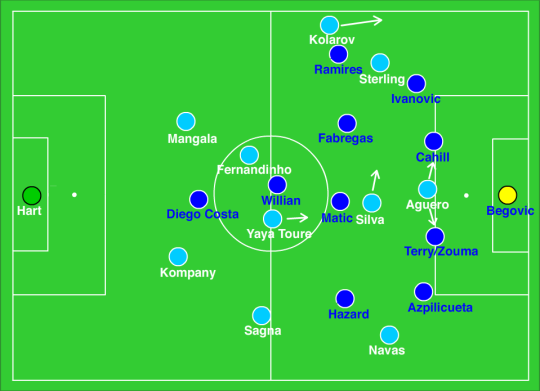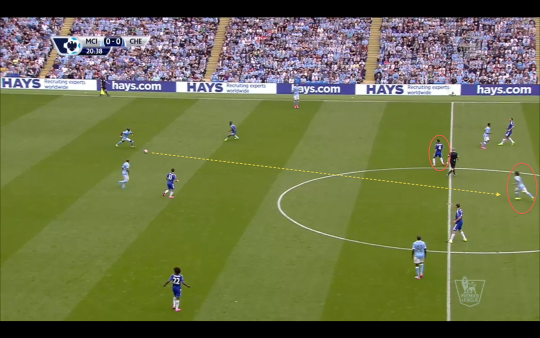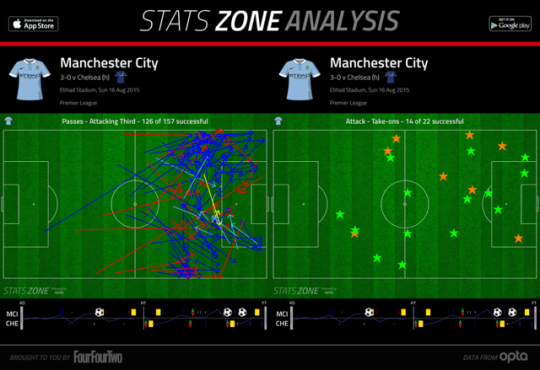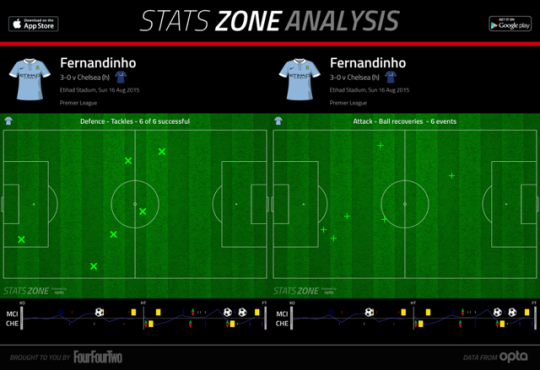Match date: 16 August 2015
An early battle of the Champions and the league runners up from last campaign and it was a very good battle for much of the match.
Manuel Pellegrini set his side out in a 4-2-3-1, something that he typically would not do at home, but then again, Manchester City were playing Chelsea, so this was a ‘big game’ and one the Chilean needed to get right. Kolarov and Sagna started at full back, while Yaya Toure anchored the midfield with Fernandinho. Raheem Sterling started on the left side of the attack in his home debut.
Jose Mourinho deployed his side in a 4-2-3-1 as well, with little surprise in his selection. Asmir Begovic started in goal as Courtois was sent off in Chelsea’s opening 2-2 draw against Swansea.
David Silva, Sergio Agüero
If Sergio Agüero were able to remain fit, he and David Silva would be the best attacking partnership in the English Premier League. Silva’s vision and passing, combined with Agüero’s movement and finishing, are to be admired and both were put on display and central to Manchester City’s win over Chelsea. Just in the opening thirty seconds of the match, Silva slipped Agüero through with a delightful ball only for Begovic to come up with an excellent save.
There were a few different reasons as to why the two players had the influential displays that they did. The first reason starts with how both sides set up. As mentioned above, Pellegrini and Mourinho both opted for a 4-2-3-1, but there were distinct differences in how each side employed their midfield triangle when in possession of the ball. For Chelsea, Fabregas and Matic both stayed in holding roles for much of the time they were in possession with Hazard, Ramires, and Willian interchanging positions in front of them. For Manchester City, however, Yaya Toure would move forward, leaving Fernandinho as the sole holding midfield, when the home side had the ball. This started to cause problems for Chelsea. There were times when Manchester City had the ball in their half or near the midfield and Chelsea were in a midblock with some pressure on the ball and Fabregas and Matic cutting off the passing lanes into Silva and Agüero, but then Fabregas would step out of his position. This allow Silva to move laterally into the space and get on the ball relatively unopposed, while also dragging Matic over with him. Other times Matic would have to deal with Yaya Toure stepping forward and Silva would go to the opposite side. In the screen capture below, you can see Silva in space as Matic is drawn toward Toure. This particular passage of play led to an Agüero chance.
The space between the lines in the above picture is not where the opposition wants David Silva picking up the ball, but it happened time and again with Fabregas pushing too high and Matic not being able to find Silva, or both holding players playing too high and not paying attention to Silva behind them. Again in the screen capture below, you could argue that Matic is minding Yaya Toure, but Fabregas’ is strange as he is not an immediate second line of pressure nor is he cutting off the forward passing lanes.
As Manchester City pushed up the field, Silva’s movement to attract Matic became more important in opening up space for Agüero. When the ball was forced wide, Agüero was able to get onto low crosses from Navas and Kolarov in the opening half because Matic, who would usually be in the positions to cut out such passes, was closer to Silva. This allowed Agüero to get in front of Cahill and Terry before turning and shooting and forcing Begovic into two very good saves before his third chance saw him score an excellent goal after getting another ball into him inside the Chelsea penalty area.
Pellegrini’s New Side, City Attack the Left
As mentioned, David Silva and Agüero were hugely important, but Pellegrini gave them the ability to be as influential as they were with changes around them. Last year, Pellegrini liked to play a 4-4-2/4-2-2-2 or a 4-2-3-1, but in both David Silva was often played in the same line with Samir Nasri, who would play from the left a lot of the time and drift inside. This caused space to be closed down for Silva. In this match, Pellegrini flanked David Silva and Agüero with Raheem Sterling and Jesus Navas, both of whom were able to stretch Chelsea’s back line both laterally and deep with their pace and width.
City enjoyed attacking down the left, with Kolarov getting forward more effectively than Sagna did. Ramires and Willian swapped the right side position of the three behind Costa throughout the match, but neither were able to keep Kolarov back, rather the Serbian pushed back Chelsea’s right side. Combined with this was Sterling getting the best of Ivanovic throughout the match, something that has to be becoming a worry for Mourinho. Silva and Agüero enjoyed drifting out to the left as well to combined with their teammates.
Mourinho’s Changes, Fernandinho
Mourinho made a huge call at half time, replacing John Terry with Kurt Zouma. It was clear that this was a tactical decision and made sense in the match. Zouma’s presence allowed Chelsea back line to play a higher line, pushing the rest of the team up as well. This brought Chelsea back into the match more, but the match became much more open which is not something that Mourinho would have liked to have had happen. It was understandable to introduce Zouma. Mourinho has used the young Frenchman before to mark an opposing player when in a midfield role, but it was interesting that Mourinho chose to use him at centre back when the problems for Chelsea started further up the field.
The Chelsea boss’ next change was bringing on Cuadrado for Ramires in an effort to get more of an attacking threat on the right and help push back Kolarov. Chelsea had better moments in the second half, but were unable to genuinely test Joe Hart, aside from one chance that Hazard hit right at the City goalkeeper. This particular chance came after a Fernandinho spill allowed Hazard to get on the ball unopposed and then drive at the City back line. For much of the match before that, when Yaya Toure pushed forward, Fernandinho was the sole holding midfielder and did an excellent job cutting out Chelsea’s counter attacking opportunities when the visiting side were able to get past City’s first line of pressure.
Conclusion
This was one of Pellegrini’s best matches as Manchester City boss and one of Mourinho’s worst matches as Chelsea boss, and one of his worst tactical performances in a ‘big game.’
Mourinho wants to play Fabregas alongside Matic; the Spaniard has the ability to dictate the match with his passing, while Matic is there for the defensive work. However, Fabregas can certainly dictate the game further up the field and in bigger matches, his lack of discipline would not be exposed as much. Some may point to the fact that Fabregas had the most tackles for Chelsea in the match, but none were in the middle third of the field and most were in Chelsea’s defensive third when Manchester City were putting a lot of pressure on Chelsea.
This is the first time that Chelsea have failed to win either of their opening two matches under Mourinho, while Manchester City find themselves at the top of the table.
Peter Motzenbecker
Latest posts by Peter Motzenbecker (see all)
- Liverpool vs Manchester City: Tactical Analysis - January 17, 2018
- The Manchester Derby: Post-Match Tactical Analysis - September 13, 2016
- Arsenal vs Liverpool: The Tactical View - August 17, 2016







